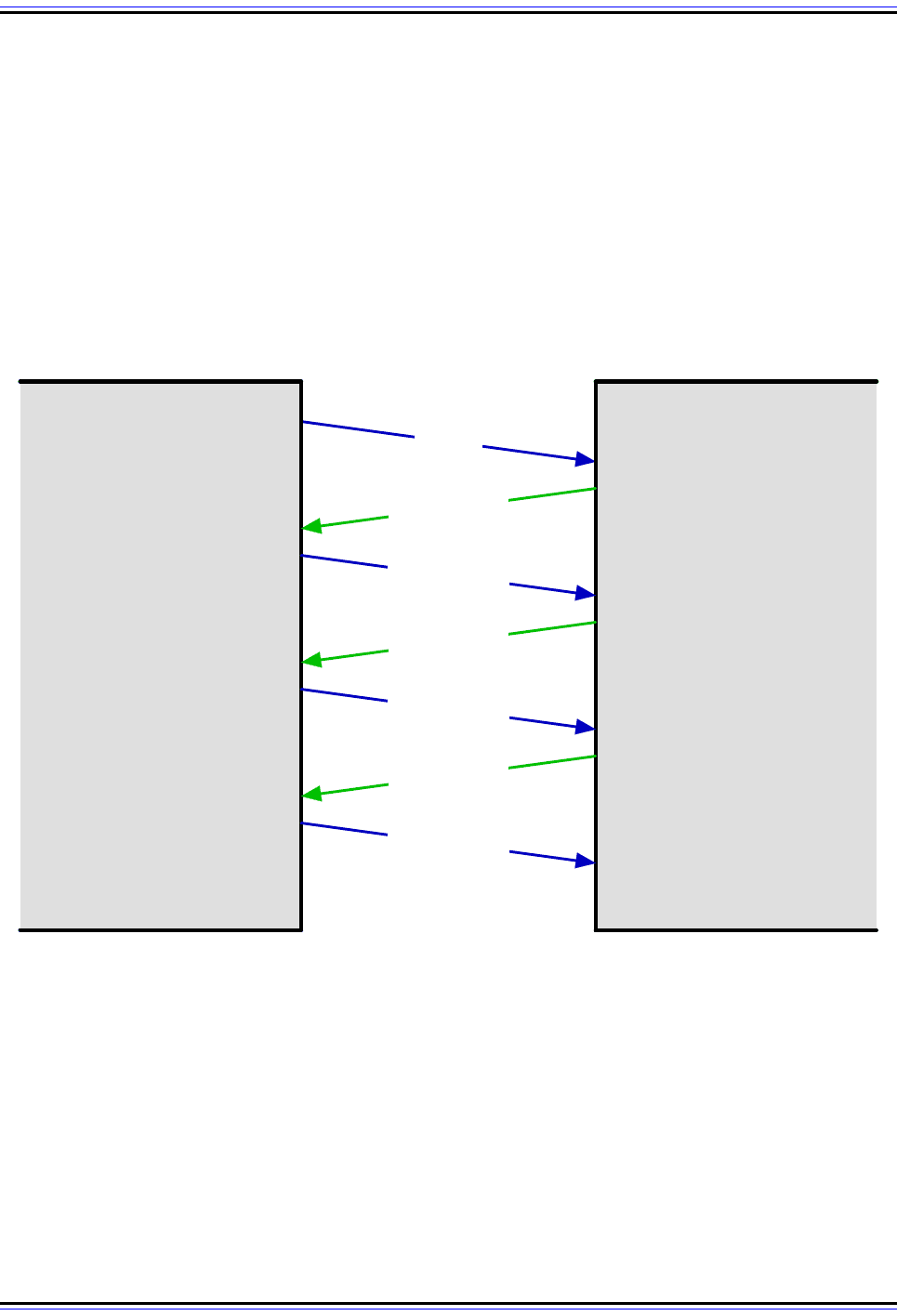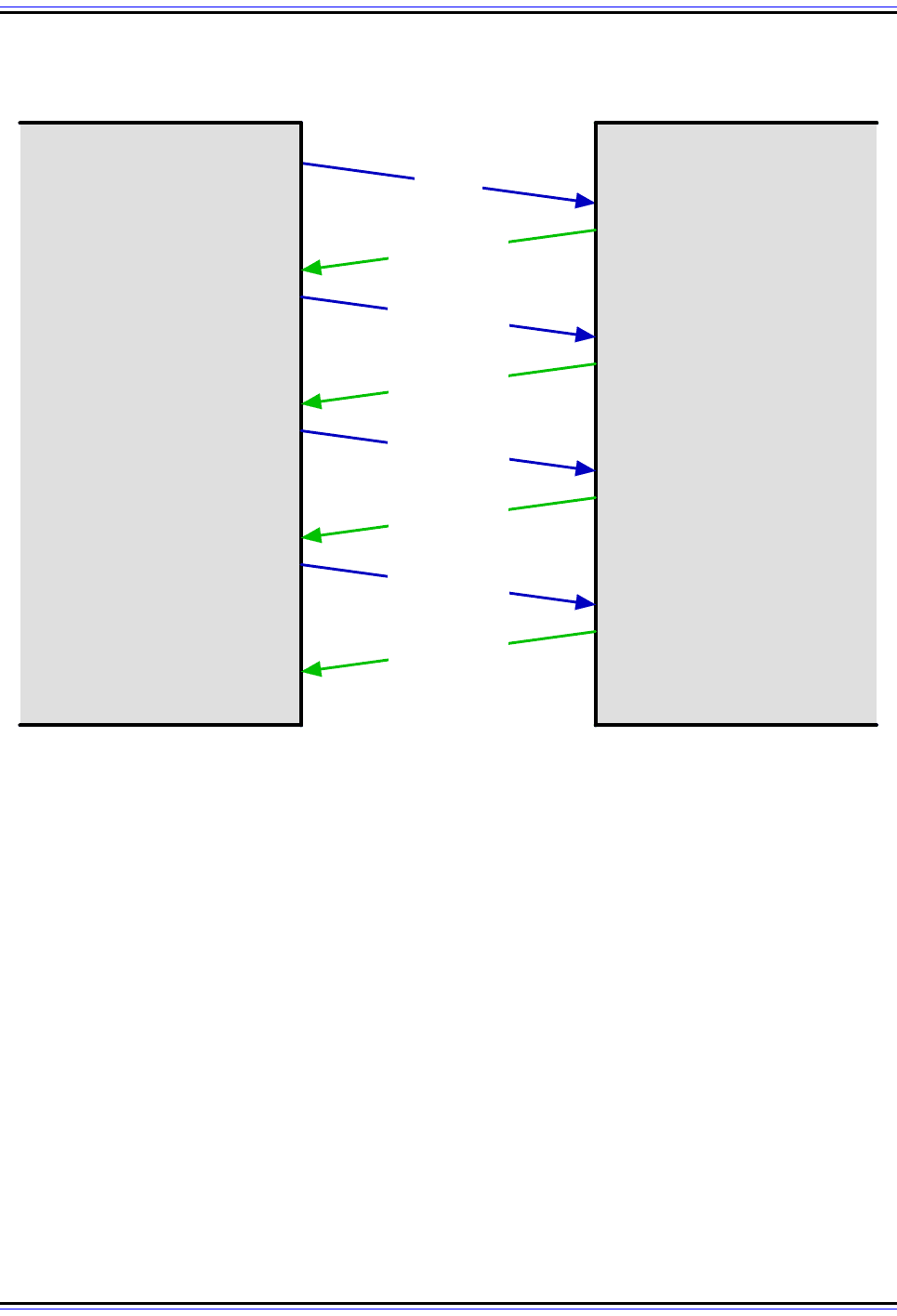Charles M. Kozierok The TCP-IP Guide
Подождите немного. Документ загружается.


The TCP/IP Guide - Version 3.0 (Contents) ` 1351 _ © 2001-2005 Charles M. Kozierok. All Rights Reserved.
Trivial File Transfer Protocol (TFTP)
The File Transfer Protocol (FTP) implements a full set of command and reply functionality
that enables a user to perform a wide range of file movement and manipulation tasks
between two TCP/IP machines. It is ideal as a general purpose protocol for file transfer
between computers, but on certain types of hardware, it is too complex to easily implement,
and provides more capabilities than are really needed. In cases where only the most basic
file transfer functions are needed and simplicity and small program size is of paramount
importance, a companion to FTP was created called the Trivial File Transfer Protocol
(TFTP).
In this section I provide a description of the operation of TFTP. I begin with an overview
description of the protocol, its history and motivation, and the relevant standards that
describe it. I discuss its operation in general terms and how TFTP clients and server
communicate, and explain TFTP messaging in detail. I then discuss TFTP options and the
TFTP option negotiation mechanism, and conclude by showing the various TFTP message
formats.
Background Information: While TFTP is a distinct protocol from FTP, explaining
the former is easier when the reader is familiar with the latter. I assume that the
reader has some understanding of FTP, since it is the more commonly-used
protocol. If you have come to this section prior to reading the section on FTP, I'd
recommend at least reading the FTP overview topic before proceeding.
TFTP Overview, History and Standards
The File Transfer Protocol (FTP) is the main protocol used for the majority of general file
transfers in TCP/IP internetworks. One of the objectives of the designers of FTP was to
keep the protocol relatively simple, but that was really only possible to a limited extent. To
enable the protocol to be useful in a variety of cases and between many kinds of devices,
FTP needed a fairly large set of features and capabilities. As a result, while FTP is not as
complex as certain other protocols, it is still fairly complicated in a number of respects.
The Need for TFTP
The complexity of FTP is partially due to the protocol itself, with its dozens of commands
and reply codes, and partly due to the need to use of the Transmission Control Protocol
(TCP) for connections and data transport. The reliance on TCP means that any device
wanting to use FTP needs not only the FTP program, but also a full TCP implementation as
well. It must handle FTP's need for simultaneous data and control channel connections and
other requirements.
For a conventional computer, like a regular PC, Macintosh or UNIX workstation, none of this
is really an issue, especially with today's large hard disks and fast, cheap memory. But
remember that FTP was developed over three decades ago, when hardware was slow and

The TCP/IP Guide - Version 3.0 (Contents) ` 1352 _ © 2001-2005 Charles M. Kozierok. All Rights Reserved.
memory was expensive. Furthermore, even today, regular computers are not the only
devices used on networks. There are some networked devices that do not have the capabil-
ities of “true” computers, but still need to be able to do file transfers. For these devices, a full
FTP and TCP implementation is a non-trivial matter.
One of the most notable examples of devices where this is an issue are diskless worksta-
tions. These are computers that have no permanent storage, so when they start up, they
cannot read a whole TCP/IP implementation from a hard disk like most computers do easily.
They start with only a small amount of built-in software, and must obtain configuration infor-
mation from a server and then download the rest of their software from another network
device. The same issue arises for certain other hardware devices with no hard disks.
The process of starting up these devices is commonly called bootstrapping and occurs in
two phases. First, the workstation is provided with an IP address and other parameters,
through the use of a host configuration protocol such as BOOTP or DHCP. Second, the
client downloads software, such as an operating system and drivers, that let it function on
the network like any other device. This requires the ability to transfer files quickly and easily.
The instructions to perform this bootstrapping must fit onto a read-only memory (ROM) chip
and this makes the size of the software an important issue—again, especially many years
ago.
The solution to this need was to create a “light” version of FTP that would emphasize small
program size and simplicity over functionality. This new protocol, called the Trivial File
Transfer Protocol (TFTP), was initially developed in the late 1970s, and first standardized in
1980. The modern version, called TFTP version 2, was documented in RFC 783 in 1981,
which was revised and published as RFC 1350, The TFTP Protocol (Revision 2), in 1992.
This is the current version of the standard.
Comparing FTP and TFTP
Probably the best way of understanding the relationship between TFTP and FTP is to
compare it to the relationship between TCP and UDP at the transport layer. UDP is a
simplified, “stripped-down” alternative to TCP, used when simplicity is more important than
rich functionality. Similarly, TFTP is a greatly simplified version of FTP that allows only basic
operations and lacks some of FTP's fancy capabilities, in order to keep its implementation
easy (even “trivial”!) and its program size small.
Some of the more significant specific differences between FTP and TFTP:
☯ Transport: The comparison to TCP and UDP is apt not only based on the features/
simplicity trade-off, but because FTP uses TCP for transport while TFTP uses UDP.
Like TFTP, UDP is simple and this makes the two ideal for embedding together as a
hardware program set in a network device.
☯ Limited Command Set: FTP includes a rich set of commands to allow files to be sent,
received, renamed, deleted and so forth. TFTP only allows files to be sent and
received.
☯ Limited Data Representations: TFTP does not include some of FTP's fancy data
representation options; it allows only simple ASCII or binary file transfers.

The TCP/IP Guide - Version 3.0 (Contents) ` 1353 _ © 2001-2005 Charles M. Kozierok. All Rights Reserved.
☯ Lack of Authentication: UDP uses no login mechanism or other means of authenti-
cation. This is again a simplification, though it means the operators of TFTP servers
must severely restrict the files they make available for access. (It is also part of why
TFTP specifically does not allow the client to perform “dangerous” file operations such
as deletion.)
Due to its limitations, TFTP is a complement to the regular File Transfer Protocol, not a
replacement for it. It is used only when its simplicity is important and its lack of features is
not. Its most common application is bootstrapping, as described above, though it can be
used for other purposes. One specific application that the TFTP standard describes for the
protocol is the transport of electronic mail. While the protocol supports this explicitly, TFTP
is not generally used today for this purpose.
Overview of TFTP Operation
Communication and messaging in TFTP is very different than it is in FTP because of the
different transport layer protocols used by each. FTP makes use of TCP's rich functionality,
including its stream data orientation, to allow it to send bytes of data directly over the FTP
data connection. TCP also takes care of reliable delivery of data for FTP, ensuring files are
received correctly. In contrast, since TFTP uses UDP, it must package data into individual
messages for both protocol control and data communication. TFTP must also take care of
timing transmissions to detect lost datagrams and then retransmitting as needed.
TFTP servers allow connections from TFTP clients to perform file send and receive opera-
tions. Many hosts that run FTP servers will also run a separate TFTP server module as well.
TFTP users initiate connections by starting a TFTP client program, which generally uses a
command-line interface similar to that of many FTP clients; the main difference is the much
smaller number of commands in TFTP.
Key Concept: For situations where the full File Transfer Protocol (FTP) is either
unnecessary or impractical, the simpler Trivial File Transfer Protocol (TFTP) was
developed. TFTP is like FTP in that it is used for general file transfer between a client
and server device, but it is stripped down in its capabilities. Rather than including a full
command set and using TCP for communication like FTP, TFTP can only be used for
reading or writing a single file, and uses the fast but unreliable UDP for transport. It is often
preferred in situations where small files must be transferred quickly and simply, such as
bootstrapping diskless workstations.
TFTP Option Extension and TFTP Options
The basic operation of TFTP has not changed since RFC 1350 was published, but a new
feature was added to the protocol in 1995. RFC 1782, TFTP Option Extension, defines a
mechanism by which a TFTP client and TFTP server can negotiate certain parameters that
will control a file transfer prior to the transfer commencing. This allows more flexibility in
how TFTP is used, adding a slight amount of complexity to TFTP, but not a great deal.

The TCP/IP Guide - Version 3.0 (Contents) ` 1354 _ © 2001-2005 Charles M. Kozierok. All Rights Reserved.
The option extension is backwards-compatible with regular TFTP, and is only used if both
server and client support it. Two subsequent RFCs define the actual options that can be
negotiated: RFC 1783, TFTP Blocksize Option and RFC 1784, TFTP Timeout Interval and
Transfer Size Options. This set of three RFCs (1782, 1783 and 1784) was replaced in 1998
by updated versions in RFCs 2347, 2348 and 2349.
TFTP General Operation, Connection Establishment and Client/Server
Communication
Since the “T” in “TFTP” stands for “trivial”, and the protocol was specifically designed to be
simple, you would think that describing how it works would, in fact, be simple, wouldn't you?
Well, actually, it pretty much is. Sorry, I couldn't resist setting you up there. ☺
TFTP communication is client/server based, as discussed in the overview. The process of
transferring a file consists of three main phases. In highly generalized terms, these are:
1. Initial Connection: The TFTP client establishes the connection by sending an initial
request to the server. The server responds back to the client and the connection is
effectively opened.
2. Data Transfer: Once the connection is established, the client and server exchange
TFTP messages. One device sends data and the other sends acknowledgments.
3. Connection Termination: When the last TFTP message containing data has been
sent and acknowledged, the connection is terminated.
Connection Establishment and Identification
The concept of a “connection” is somewhat different in TFTP than it is with a protocol like
FTP that uses TCP. FTP must establish a connection at the TCP level before anything can
be done by FTP itself. TFTP, however, uses the connectionless UDP for transport, so there
is no connection in the sense that one exists in TCP. In TFTP, the connection is more in a
“logical sense”, meaning that the client and server are participating in the protocol and
exchanging TFTP messages.
The TFTP server listens continuously for requests on well-known UDP port number 69,
which is reserved for TFTP. The client chooses for its initial communication an ephemeral
port number, as is usually the case in TCP/IP. This port number actually identifies the data
transfer, and is called a transfer identifier (TID).
What's different about TFTP, however, is that the server also selects a pseudo-random TID
that it uses for sending responses back to the client; it doesn't send them from port number
69. The reason this is done is that by using unique client port number and source port
number, multiple TFTP exchanges can be conducted simultaneously by a server. Each
transfer is identified automatically by the source and destination port number, so there is no
need to identify in data messages the transfer to which each block data belongs. This keeps
the TFTP header size down, allowing more of each UDP message to contain actual data.

The TCP/IP Guide - Version 3.0 (Contents) ` 1355 _ © 2001-2005 Charles M. Kozierok. All Rights Reserved.
For example, suppose the TFTP client selects a TID of 3,145 for its initial message. It would
send a UDP transmission from its port 3,145 to the server's port 69. Say the server selects
a TID of 1,114. It would send its reply from its port 1,114 to the client's port 3,145. From then
on, the client would send messages back to server port 1,114 until the TFTP session was
completed.
"Lock-Step" Client/Server Messaging
After the initial exchange, the client and server exchange data and acknowledgment
messages in “lock-step” fashion. Each device sends a message for each message it
receives: one device sends data messages and waits for acknowledgments, the other
sends acknowledgments and waits for data messages. This form of rigid communication is
less efficient than allowing the transmitter to “fire away” with one data message after
another, but is important because it keeps TFTP simple when it comes to an important
issue: retransmissions.
Like all protocols using the unreliable UDP, TFTP has no assurances that any messages
sent will in fact arrive at their destination, so it must use timers to detect lost transmissions
and resend them. What is different about TFTP is that both clients and servers perform
retransmission. The device that is sending data messages will resend the data message if it
doesn't receive an acknowledgment in a reasonable period of time; the device sending the
acknowledgments will resend the acknowledgment if it doesn't receive the next data
message promptly. The “lock-step” communication discussed above greatly simplifies this
process, since each device only needs to keep track of one “outstanding” message at a
time. It also eliminates the need to deal with complications such as reorganizing blocks
received out of order (which protocols like FTP rely on TCP to manage.)
Key Concept: Since TFTP uses UDP rather than TCP, there is no explicit concept of
a connection as in FTP. A TFTP session instead uses the concept of a “logical
connection”, which is opened when a client sends a request to a server to read or
write a file. Communication between the client and server is performed in “lock-step”
fashion: one device sends data messages and receives acknowledgments so it knows the
data messages were received; the other sends acknowledgments and receives data
messages so it knows the acknowledgments were received.
Difficulties With TFTP's Simplified Messaging Mechanism
One of the most important drawbacks with this technique is that while it simplifies communi-
cation, it does so at the cost of performance. Since only one message can be in transit at a
time, this limits throughput to a maximum of 512 bytes for exchange of messages between
the client and server. In contrast, when using FTP, large amounts of data can be pipelined;
there is no need to wait for an acknowledgment for the first piece of data before sending the
second.

The TCP/IP Guide - Version 3.0 (Contents) ` 1356 _ © 2001-2005 Charles M. Kozierok. All Rights Reserved.
Another complication is that if a data or acknowledgment message is re-sent and the
original was not lost but rather just delayed, two copies will show up. The original TFTP
protocol rules stated that upon receipt of a duplicate datagram, the device receiving it may
re-send the current datagram again. So, receipt of a duplicate block #2 by a client doing a
read would result in the client sending a duplicate acknowledgment for block #2. This would
mean two acknowledgments received by the server, which would in turn send block #3
twice. Then there would be two acknowledgments for block #3, and so on.
The end result of this is that once the initial duplication occurs, every message thereafter is
sent twice. This has been affectionately dubbed the Sorcerer's Apprentice Bug, after the
story used as the basis of the famous scene in Disney's Fantasia where Mickey Mouse cuts
animated brooms in half only to find that in turn, each half comes to life. This problem was
fixed by changing the rules so that only the device receiving a duplicate data message may
send a duplicate acknowledgment. Receipt of a duplicate acknowledgment does not result
in sending a duplicate data message. Since only one of the two devices can send dupli-
cates, this fixes the problem.
It’s also worth emphasizing that TFTP includes absolutely no security, so there is no login or
authentication process. As mentioned in the overview, administrators must use caution in
deciding what files to make available via TFTP, and in allowing write access to TFTP
servers.
TFTP Detailed Operation and Messaging
TFTP operation consists of three general steps: initial connection, data transfer, and
connection termination. All operations are performed through the exchange of specific
TFTP messages. Let's take a more detailed look now at these three phases of operation
and the specifics of TFTP messaging functions.
Initial Message Exchange
The first message sent by the client to initiate TFTP is either a read request (RRQ)
message or a write request (WRQ) message. This message serves to implicitly establish
the logical TFTP connection, and to indicate if the file is to be sent from the server to the
client (read request) or the client to the server (write request). The message also specifies
the type of file transfer to be performed. TFTP supports two transfer modes: netascii mode
(ASCII text files as used by the Telnet Protocol) and octet mode (binary files).
Note: There was originally a third file type option—mail mode—but TFTP was
never really designed for transmitting mail and this option is now obsolete.

The TCP/IP Guide - Version 3.0 (Contents) ` 1357 _ © 2001-2005 Charles M. Kozierok. All Rights Reserved.
Assuming there was no problem with the request (such as a server problem, inability to find
the file, etc.) the server will respond with a positive reply. In the case of a read request, the
server will immediately send the first data message back to the client. In the case of a write
request, the server will send an acknowledgment message to the client, telling it that it may
proceed to send the first data message.
After the initial exchange, the client and server exchange data and acknowledgment
messages in “lock-step” fashion as described in the previous topic. For a read, the server
sends one data message and waits for an acknowledgment from the client before sending
the next one. For a write, the client sends one data message and the server sends an
acknowledgment for it, before the client sends the next data message.
If there is a problem at any stage of the connection establishment or transfer process, a
device may reply with an error message instead of a data or acknowledgment message, as
appropriate. An error message normally results in the failure of the data transfer; this is one
of the prices paid for the simplicity of TFTP.
Each TFTP file transfer proceeds using one of the processes described below, which either
reads or writes a single file. If another file needs to be sent or received, a new logical
communication is established, in a manner analogous to how FTP creates data connec-
tions. The main difference is that TFTP has no persistent control connection like FTP does.
Data Block Numbering
Each data message contains a block of between 0 and 512 bytes of data. The blocks are
numbered sequentially, starting with 1. The number of each block is placed in the header of
the data message carrying that block, and then used in the acknowledgment for that block
so the original sender knows it was received. The device sending the data will always send
512 bytes of data at a time for as long as it has enough data to fill the message. When it
gets to the end of the file and has fewer than 512 bytes to send, it will send only as many
bytes as remain. Interestingly, this means that if the size of the file is an exact multiple of
512, the last message sent will have zero bytes of data!
The receipt of a data message with between 0 and 511 bytes of data signals that this is the
last data message. Once this is acknowledged, this automatically signals the end of the
data transfer. There is no need to explicitly terminate the “connection”, just as it was not
necessary to explicitly establish it.
TFTP Read Process Steps
Let's use an example to see how TFTP messaging works. Suppose the client wants to read
a particular file that is 1,200 bytes long. Here are the steps in simplified form (also displayed
in Figure 293):
1. The client sends a read request to the server, specifying the name of the file.
2. The server sends back a data message containing block #1, carrying 512 bytes of
data.
3. The client receives the data, and sends back an acknowledgment for block #1.

The TCP/IP Guide - Version 3.0 (Contents) ` 1358 _ © 2001-2005 Charles M. Kozierok. All Rights Reserved.
4. The server sends block #2, with 512 bytes of data.
5. The client receives block #2, and sends back an acknowledgment for it.
6. The server sends block #3, containing 176 bytes of data. It waits for an acknowl-
edgment before terminating the logical connection.
7. The client receives the data, sends an acknowledgment for block #3. Since this data
message had fewer than 512 bytes, it knows the file is complete.
8. The server receives the acknowledgment, and knows the file was received
successfully.
TFTP Write Process Steps
Here are the steps in the same process, but where the client is writing the file (see Figure
294):
1. The client sends a write request to the server, specifying the name of the file.
Figure 293: TFTP Read Process
In this example, the client starts the process of reading a file by sending a request for it to the server. The
server acknowledges this request by immediately sending a DATA message carrying block #1, containing the
first 512 bytes of the file. The client acknowledges this with an ACK message for block #1. The server then
sends block #2, containing bytes 513 to 1,024, which the client acknowledges. When the client receives block
#3, it realizes it has only 176 bytes, which marks it as the last block of the file.
TFTP ServerTFTP Client
RRQ
1. Send Read Request
For File
2. Receive Read Request,
Send Data Bytes 1 to 512
4. Receive Acknowledgment,
Send Data Bytes 513 to 1,024
3. Receive Block #1,
Send Acknowledgment
DATA
(Block #1)
ACK
(Block #1)
DATA
(Block #2)
5. Receive Block #2,
Send Acknowledgment
ACK
(Block #2)
6. Receive Acknowledgment,
Send Data Bytes 1,025 to 1,200
DATA
(Block #3)
ACK
(Block #3)
7. Receive Block #3,
Send Acknowledgment
8. Receive Acknowledgment;
File Transfer Complete

The TCP/IP Guide - Version 3.0 (Contents) ` 1359 _ © 2001-2005 Charles M. Kozierok. All Rights Reserved.
2. The server sends back an acknowledgment. Since this acknowledgment is prior to the
receipt of any data, it uses block number zero in the acknowledgment.
3. The client sends a data message containing block #1, 512 bytes of data.
4. The server receives the data, sends back an acknowledgment for block #1.
5. The client sends block #2, 512 bytes of data.
6. The server receives the data, sends back an acknowledgment for block #2.
7. The client sends block #3, containing 176 bytes of data. It waits for an acknowl-
edgment before terminating the logical connection.
8. The server receives block #3 and sends an acknowledgment for it. Since this data
message had fewer than 512 bytes, the transfer is done.
9. The client receives the acknowledgment for block #3 and knows the file write was
completed successfully.
Key Concept: A TFTP read operation begins with the client sending a Read
Request message to the TFTP server; the server then sends the file in 512-byte
Data messages, waiting after each one for the client to acknowledge receipt before
sending the next. A TFTP write operation starts with a Write Request sent by the client to
the server, which the server acknowledges. The client then sends the file in 512-byte Data
blocks, waiting after each for the server to acknowledge receipt. In both cases there is no
explicit means by which the end of a transfer is marked; the device receiving the file simply
knows the transfer is complete when it receives a Data message containing fewer than 512
bytes.
TFTP Options and Option Negotiation
One of the difficulties that designers of simple protocols and applications seem to have is
keeping them simple. Many protocols start out small but over time, well-intentioned users
suggest improvements that are added slowly but surely. Eventually, the program that was
once “lean and mean” has become, well, shall we say, “well-marbled”. ☺ In the software
industry, this is called “feature creep” and it has happened to many protocols and
applications.
The temptation to add features is especially strong when the program or protocol has few to
begin with. Given this, the maintainers of the TFTP protocol have done a good job over the
years of avoiding this pitfall. However, they did allow one new feature to be added to the
protocol in 1995: the TFTP Option Extension, which describes how a TFTP client and
server can negotiate options before transferring a file.
The reason for adding this capability is that the original TFTP protocol provided no way at
all for the client and server to exchange important control information prior to sending a file.
This limited the flexibility of the protocol to deal with special cases, such as the transfer of
data over unusual network types. The TFTP option negotiation feature allows additional
parameters to be exchanged between the client and server which govern how data is trans-

The TCP/IP Guide - Version 3.0 (Contents) ` 1360 _ © 2001-2005 Charles M. Kozierok. All Rights Reserved.
ferred. It does this without significantly complicating the protocol, and is backward-
compatible with normal TFTP. It is only used if both client and server support it, and one
device trying to use the feature will not cause problems if the other doesn't support it.
TFTP Option Negotiation Process
The client begins the negotiation by sending a modified TFTP Read Request or Write
Request message. In addition to the normal information that appears in this message (see
the next topic), a list of options may also be included. Each is specified with an Option Code
and an Option Value. The names and values are expressed as ASCII strings, terminated by
a null character (zero byte). Multiple options may be specified in the request message.
Figure 294: TFTP Write Process
This example shows the client sending the same 1,200-byte file to the server that it read in Figure 293. The
client sends a write request to the server, which acknowledges it; it uses block #0 to represent acknowl-
edgment of the request prior to receipt of any data. The client then sends blocks of data one at a time, each of
which is acknowledged by the server. When the server receives block #3 containing fewer than 512 bytes of
data, it knows it has received the whole file.
TFTP ServerTFTP Client
WRQ
1. Send Write Request
With File Name
2. Receive Write Request,
Send Acknowledgment
4. Receive Block #1,
Send Acknowledgment
3. Receive Acknowledgment,
Send Data Bytes 1 to 512
ACK
(Block #0)
DATA
(Block #1)
ACK
(Block #1)
DATA
(Block #2)
ACK
(Block #2)
DATA
(Block #3)
8. Receive Block #3,
Send Acknowledgment
5. Receive Acknowledgment,
Send Data Bytes 513 to 1,024
6. Receive Block #2,
Send Acknowledgment
7. Receive Acknowledgment,
Send Data Bytes 1,025 to 1,200
ACK
(Block #3)
9. Receive Acknowledgment;
File Transfer Complete
